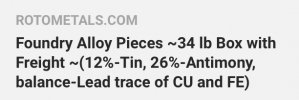You are using an out of date browser. It may not display this or other websites correctly.
You should upgrade or use an alternative browser.
You should upgrade or use an alternative browser.
What about this?
- Thread starter ChestnutLouie
- Start date
CZ93X62
Official forum enigma
I was gifted about 100# of foundry type 30 years ago. I added it 1 part to 5 parts of unalloyed lead, and got real close to Taracorp/Hardball alloy hardness (14-15 BHN) for rifle and Magnum revolver bullets. That 100# lasted about 25 years. It didn't produce any more dross and crud than any other casting alloy. I have found that harder alloys seem less prone to feeding stoppages in older autopistols not designed to run JHP or cast bullets. FWIW. Hardness will not reduce or prevent barrel leading in and of itself, if that is your goal--bullets fit well in the cylinder's or barrel's throats prevent leading. Also make sure that your case necks aren't so small that they reduce bullet diameter and therefor induce barrel leading via too-small bullets. Bullet hardness might prevent leading only because a harder bullet is less likely to be sized down during seating into a too-small case neck.

